
Global manufacturing solutions provider Flex (NASDAQ: FLEX) reported revenue ahead of Wall Street’s expectations in Q1 CY2025, with sales up 3.7% year on year to $6.40 billion. On the other hand, next quarter’s revenue guidance of $6.25 billion was less impressive, coming in 1.7% below analysts’ estimates. Its non-GAAP profit of $0.73 per share was 5.2% above analysts’ consensus estimates.
Is now the time to buy Flex? Find out by accessing our full research report, it’s free.
Flex (FLEX) Q1 CY2025 Highlights:
- Revenue: $6.40 billion vs analyst estimates of $6.23 billion (3.7% year-on-year growth, 2.6% beat)
- Adjusted EPS: $0.73 vs analyst estimates of $0.69 (5.2% beat)
- Adjusted EBITDA: $443 million vs analyst estimates of $514.1 million (6.9% margin, 13.8% miss)
- Management’s revenue guidance for the upcoming financial year 2026 is $25.9 billion at the midpoint, missing analyst estimates by 0.8% and implying 0.3% growth (vs -2% in FY2025)
- Adjusted EPS guidance for the upcoming financial year 2026 is $2.91 at the midpoint, beating analyst estimates by 1.8%
- Operating Margin: 4.8%, up from 2.6% in the same quarter last year
- Free Cash Flow Margin: 5%, down from 9.7% in the same quarter last year
- Market Capitalization: $14.09 billion
"We had a very strong finish to the year, with record adjusted operating margins for both Q4 and for the full year, and we delivered our fifth consecutive year of double-digit adjusted EPS growth," said Revathi Advaithi, CEO of Flex.
Company Overview
Originally known as Flextronics until its 2016 rebranding, Flex (NASDAQ: FLEX) is a global manufacturing partner that designs, engineers, and builds products for companies across industries from medical devices to solar trackers.
Sales Growth
A company’s long-term sales performance can indicate its overall quality. Any business can put up a good quarter or two, but many enduring ones grow for years.
With $25.81 billion in revenue over the past 12 months, Flex is a behemoth in the business services sector and benefits from economies of scale, giving it an edge in distribution. This also enables it to gain more leverage on its fixed costs than smaller competitors and the flexibility to offer lower prices. However, its scale is a double-edged sword because it’s harder to find incremental growth when you’ve penetrated most of the market. To accelerate sales, Flex likely needs to optimize its pricing or lean into new offerings and international expansion.
As you can see below, Flex grew its sales at a sluggish 1.3% compounded annual growth rate over the last five years. This shows it failed to generate demand in any major way and is a rough starting point for our analysis.
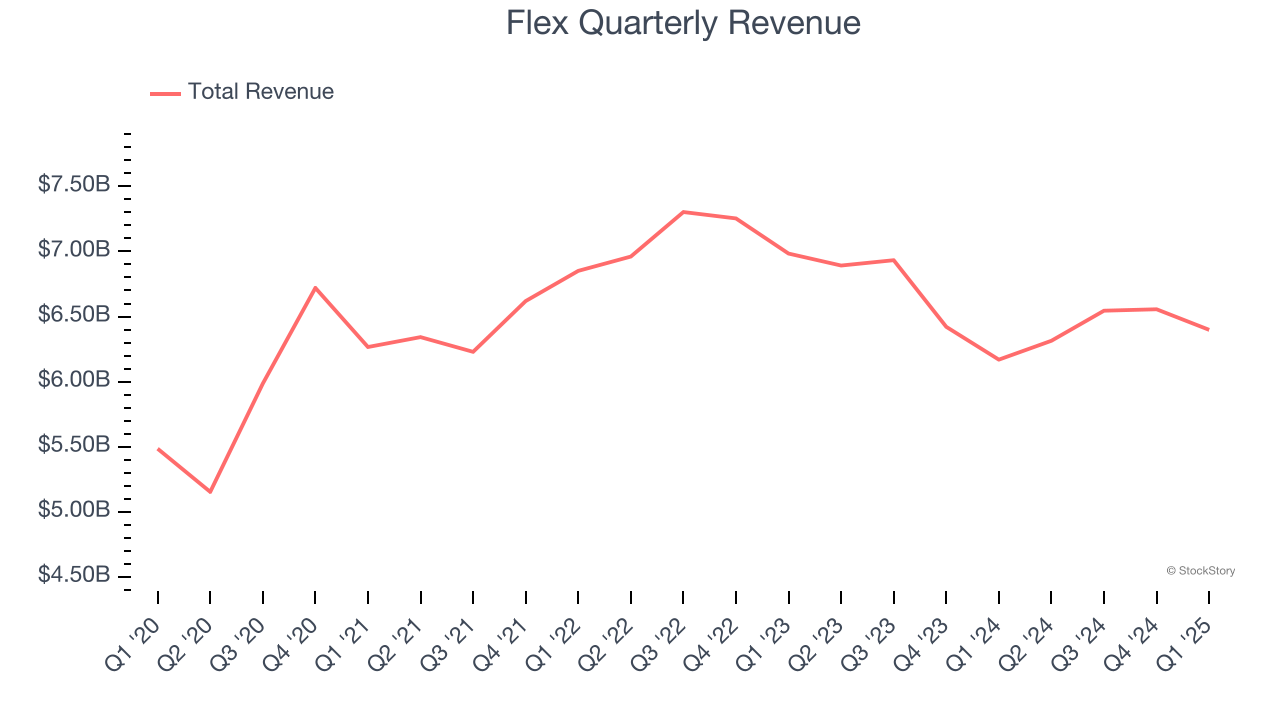
We at StockStory place the most emphasis on long-term growth, but within business services, a half-decade historical view may miss recent innovations or disruptive industry trends. Flex’s performance shows it grew in the past but relinquished its gains over the last two years, as its revenue fell by 4.8% annually. 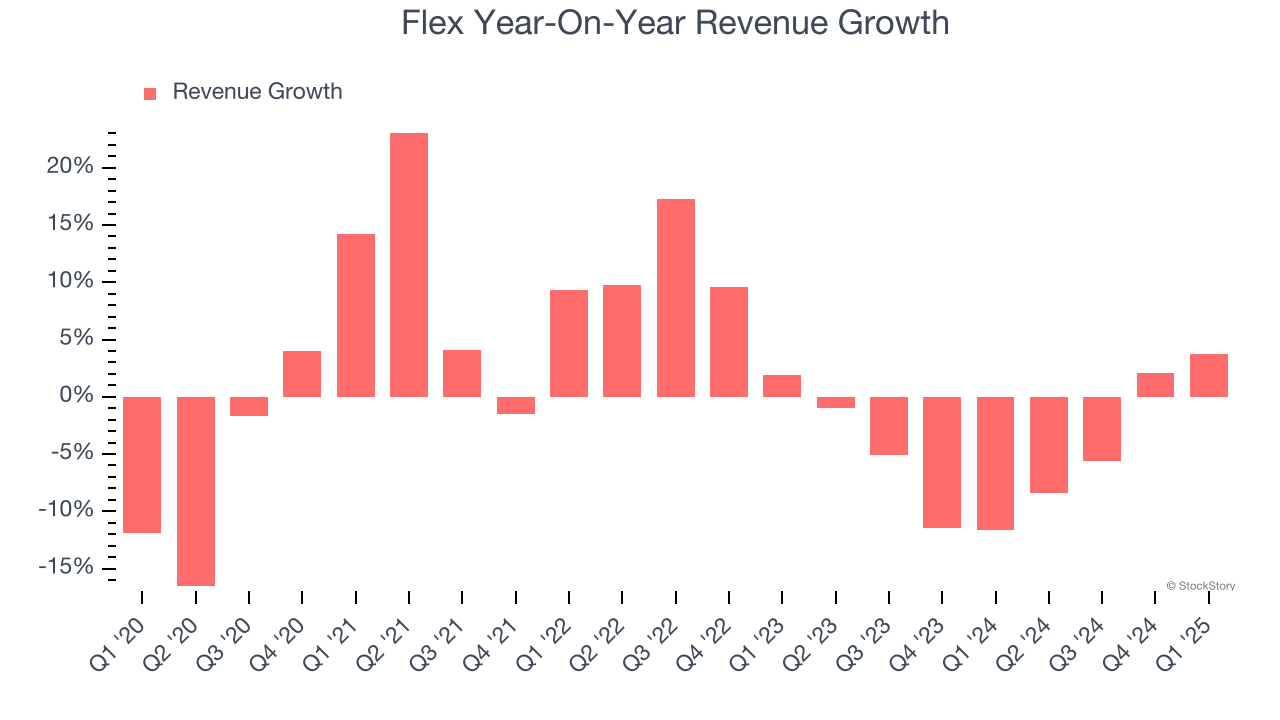
This quarter, Flex reported modest year-on-year revenue growth of 3.7% but beat Wall Street’s estimates by 2.6%. Company management is currently guiding for a 1% year-on-year decline in sales next quarter.
Looking further ahead, sell-side analysts expect revenue to grow 1.5% over the next 12 months. Although this projection implies its newer products and services will spur better top-line performance, it is still below the sector average.
Software is eating the world and there is virtually no industry left that has been untouched by it. That drives increasing demand for tools helping software developers do their jobs, whether it be monitoring critical cloud infrastructure, integrating audio and video functionality, or ensuring smooth content streaming. Click here to access a free report on our 3 favorite stocks to play this generational megatrend.
Operating Margin
Flex was profitable over the last five years but held back by its large cost base. Its average operating margin of 3.7% was weak for a business services business.
On the plus side, Flex’s operating margin rose by 1.2 percentage points over the last five years, as its sales growth gave it operating leverage.
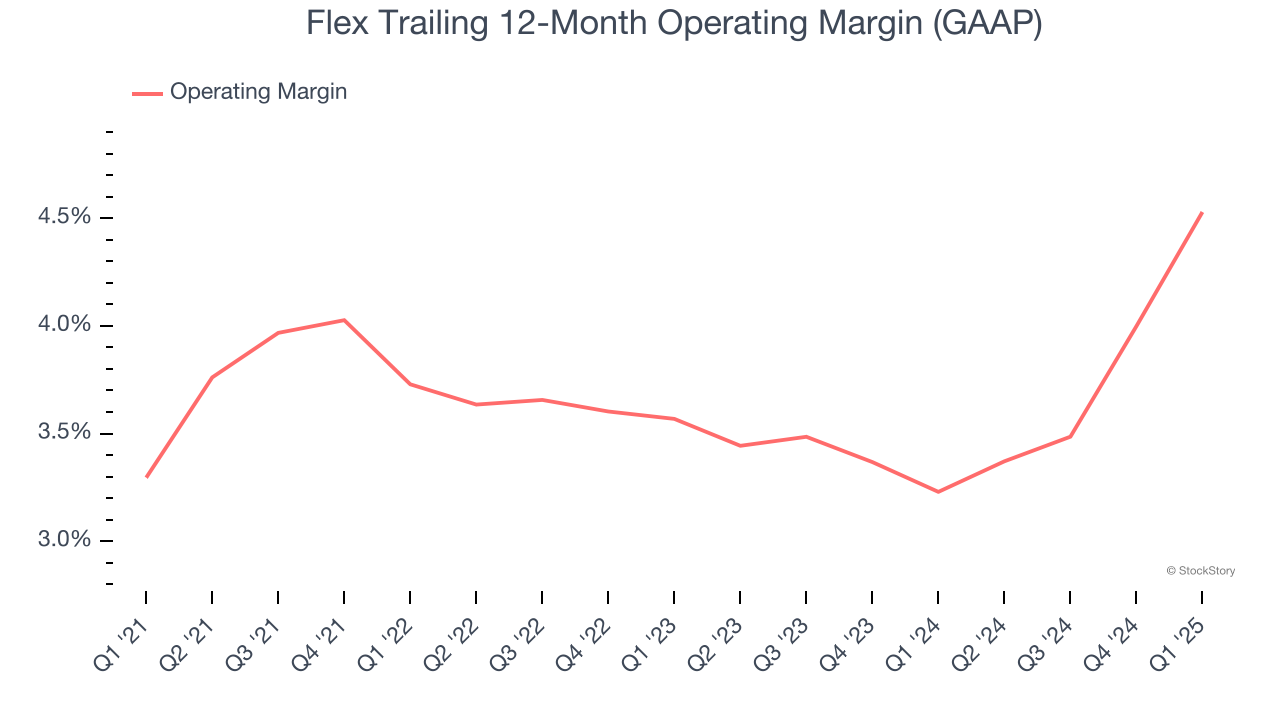
In Q1, Flex generated an operating profit margin of 4.8%, up 2.2 percentage points year on year. This increase was a welcome development and shows it was more efficient.
Earnings Per Share
We track the long-term change in earnings per share (EPS) for the same reason as long-term revenue growth. Compared to revenue, however, EPS highlights whether a company’s growth is profitable.
Flex’s EPS grew at an astounding 16.5% compounded annual growth rate over the last five years, higher than its 1.3% annualized revenue growth. This tells us the company became more profitable on a per-share basis as it expanded.
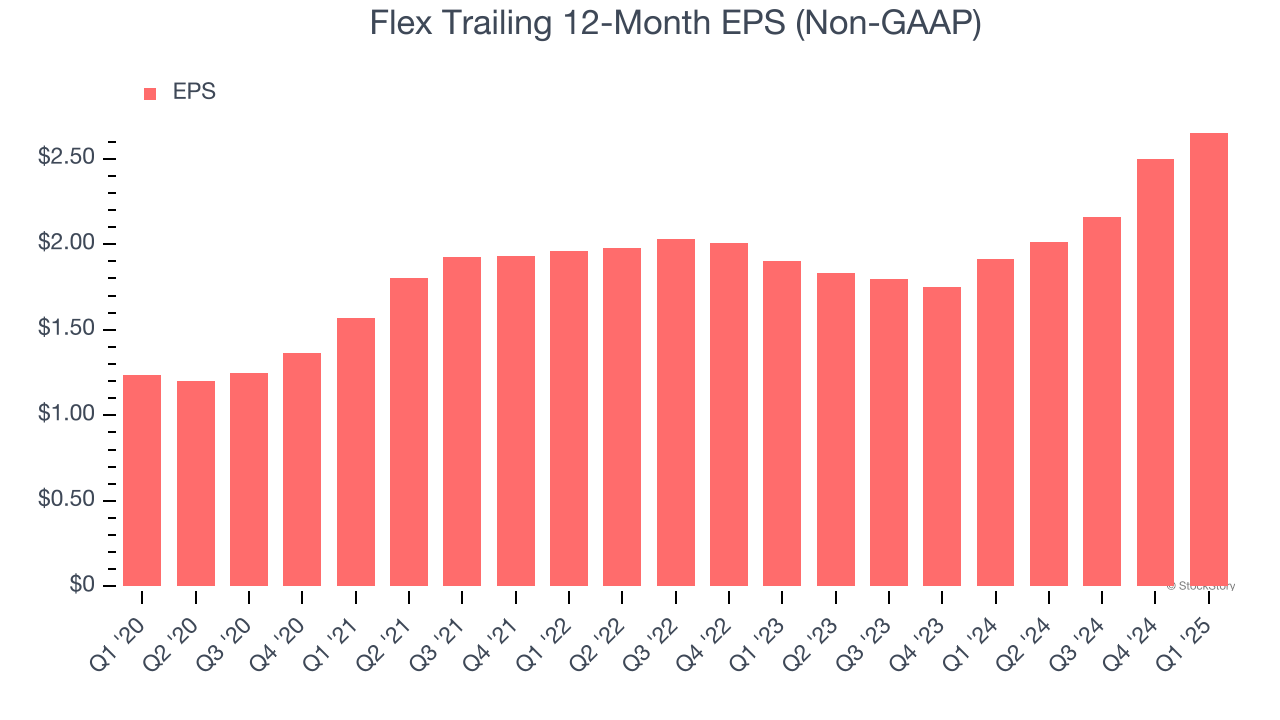
We can take a deeper look into Flex’s earnings to better understand the drivers of its performance. As we mentioned earlier, Flex’s operating margin expanded by 1.2 percentage points over the last five years. On top of that, its share count shrank by 23.1%. These are positive signs for shareholders because improving profitability and share buybacks turbocharge EPS growth relative to revenue growth. 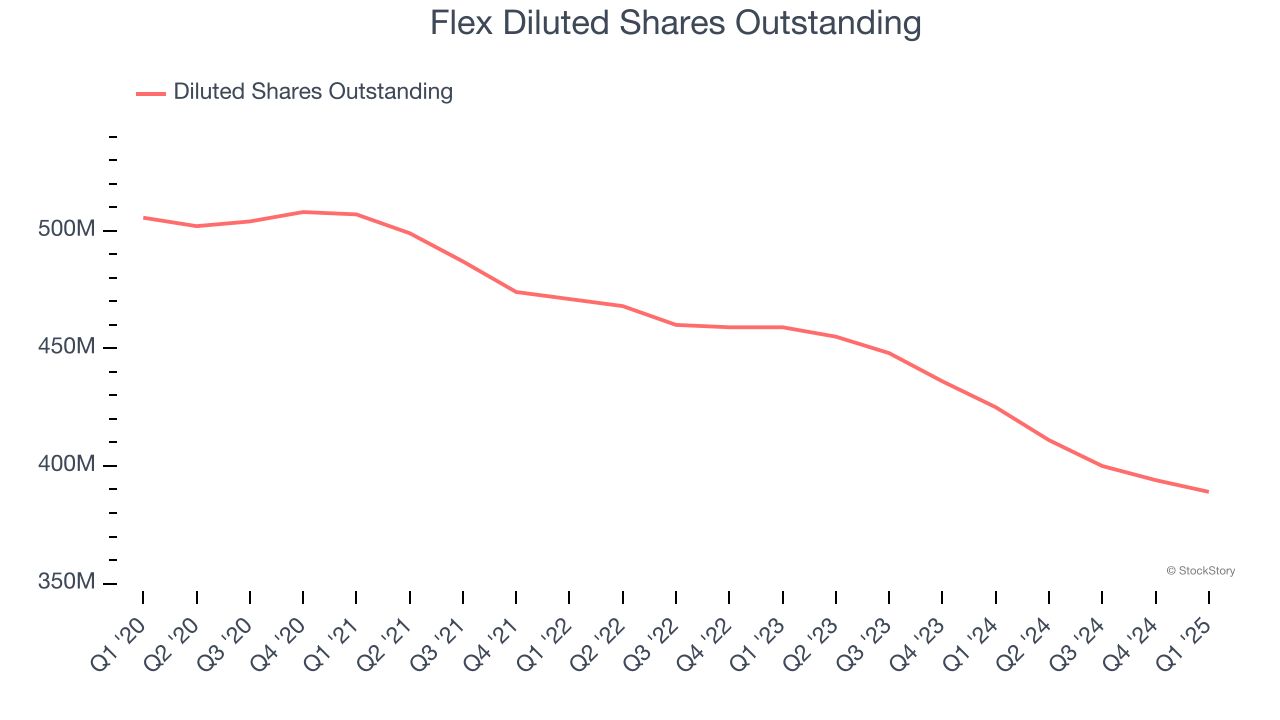
In Q1, Flex reported EPS at $0.73, up from $0.57 in the same quarter last year. This print beat analysts’ estimates by 5.2%. Over the next 12 months, Wall Street expects Flex’s full-year EPS of $2.65 to grow 6.6%.
Key Takeaways from Flex’s Q1 Results
We enjoyed seeing Flex beat analysts’ revenue expectations this quarter. We were also happy its full-year EPS guidance outperformed Wall Street’s estimates. On the other hand, its EPS guidance for next quarter missed and its revenue guidance for next quarter fell short of Wall Street’s estimates. Overall, this was a weaker quarter. The stock traded down 1.7% to $36.12 immediately after reporting.
Flex’s latest earnings report disappointed. One quarter doesn’t define a company’s quality, so let’s explore whether the stock is a buy at the current price. When making that decision, it’s important to consider its valuation, business qualities, as well as what has happened in the latest quarter. We cover that in our actionable full research report which you can read here, it’s free.





